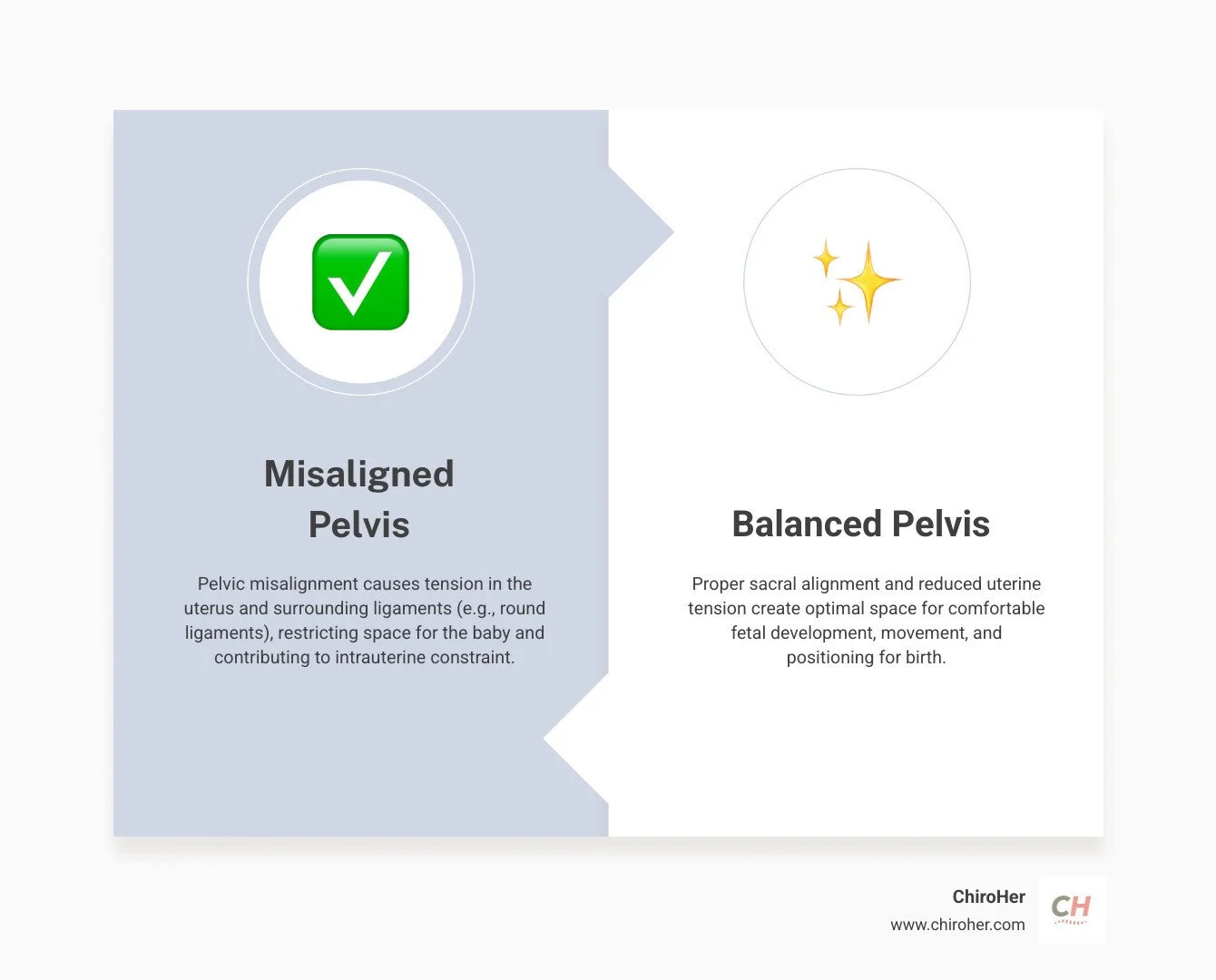The Webster Technique: How This Chiropractic Approach Supports Pregnancy
Understanding the Webster Method Chiropractor and Prenatal Care
The Webster Technique is a specific chiropractic analysis and adjustment used during pregnancy to improve pelvic balance and comfort. This gentle approach addresses sacral misalignment and tension in the surrounding muscles and ligaments. By restoring proper pelvic function, it helps reduce what is known as "intrauterine constraint," or tension in the uterus that can limit a baby's ability to move into the best position for birth.
Quick Answer: What You Need to Know
What it is: A specific chiropractic adjustment for the pelvis and sacrum during pregnancy.
Primary goal: To restore pelvic alignment and reduce muscle and ligament tension.
Key benefits: May help with back pain, sciatica, and pelvic discomfort while supporting optimal fetal positioning.
Safety: Considered safe throughout pregnancy when performed by a certified practitioner.
When to start: Beneficial at any stage, with many women increasing frequency after 35 weeks.
Developed by Dr. Larry Webster, founder of the International Chiropractic Pediatric Association (ICPA), the technique was inspired by his desire to find a gentler way to support the body's natural birthing process. By restoring pelvic balance and releasing soft tissue restrictions, the Webster Technique aims to create a more comfortable pregnancy and support a natural birth.
Hi! I'm Dr. Michelle Andrews, founder of ChiroHer in Oklahoma City. With specialized training and certification in the Webster Technique, I've helped hundreds of expecting mothers find relief and prepare their bodies for labor. As a webster method chiropractor, I provide personalized care that addresses both your comfort during pregnancy and preparation for birth.
Your Guide to the Webster Method Chiropractor
A webster method chiropractor is trained in a specific approach to pregnancy care. The technique is a detailed analysis and gentle adjustment designed to address sacral subluxation and SI joint dysfunction. Your pelvis is the foundation supporting your growing uterus, and when it's misaligned, it can create stress throughout your body.
The goal is to restore proper neuro-biomechanical function, meaning we want your pelvis and the surrounding nerves to work correctly. A balanced pelvis allows the muscles and ligaments supporting your uterus to relax, giving your baby more space to move into the best position for birth.
Importantly, the technique does not involve manually turning a baby. Instead, it removes physical restrictions that may prevent the baby from moving on their own. By addressing pelvic misalignment and releasing tension in soft tissues like the round ligaments and psoas muscles, we help reduce intrauterine constraint naturally.
How the Webster Technique Supports a Healthier Pregnancy
As your body changes during pregnancy, your shifting center of gravity and more mobile joints can lead to discomfort. The Webster Technique can help relieve many common pregnancy aches by restoring pelvic balance and reducing strain. It often provides relief for:
Low back pain: As your belly grows, your lower back curves to compensate. A balanced pelvis can take pressure off your lower back.
Sciatica: This sharp, shooting leg pain often results from pressure on the sciatic nerve due to pelvic misalignment and muscle tightness.
Pelvic girdle pain (SPD): The technique helps stabilize hypermobile pelvic joints, reducing the aching sensation at the front of the pelvis.
Round ligament pain: Gentle soft tissue work can relieve the sharp, jabbing pain from taut ligaments stretching to support the uterus.
By improving alignment and nervous system function, many women also experience better sleep and less hip discomfort. The combination of precise adjustments and soft tissue work helps your body adapt more comfortably to pregnancy. You can learn more about how this care supports you at prenatal chiropractic care.
Potential Benefits for Mother and Baby
Beyond pain relief, the Webster Technique supports your body's natural ability to give birth. A balanced pelvis and a well-functioning nervous system can lead to several benefits:
Shorter labor times: Research suggests regular chiropractic care during pregnancy may reduce labor times, with one study indicating a 25% reduction for first-time mothers and 31% for others. You can explore the research on chiropractic care and labor times.
Reduced need for interventions: With proper pelvic alignment, your baby has more room to get into an optimal birth position, which may lower the need for C-sections, forceps, or vacuum assistance.
Increased comfort and confidence: Many mothers report feeling more comfortable, mobile, and confident in their body's ability to give birth.
For the baby, a balanced pelvis means less uterine tension and more room to move. This can help them settle into the ideal head-down position and may improve blood flow, which supports healthy development. While outcomes can't be guaranteed, our goal is to create the best environment for you and your baby. For more details, visit our page on the benefits of prenatal chiropractic care.
What to Expect from a Webster Method Chiropractor
Your first visit begins with a conversation about your pregnancy and a physical examination to assess your posture, spine, and pelvic alignment. Here’s a quick overview of what care involves:
Gentle Adjustments: We use specialized pregnancy pillows and tables so you can lie comfortably. The adjustments are very gentle, often using a drop table or a light-impulse tool called an Activator. There is no pressure on your baby.
Soft Tissue Work: We also address the muscles and ligaments around your pelvis, including the round ligaments and psoas muscles. This is key to reducing uterine tension.
Personalized Schedule: The frequency of your visits depends on your needs. Some women start in the first trimester, while others begin later to address specific concerns. For issues like a breech presentation, weekly visits after 35 weeks are often recommended.
It's never too late to start, as improving pelvic balance is beneficial at any stage of pregnancy. You can get a detailed picture of your visit by reading about what to expect at a prenatal chiropractor appointment.
Is the Webster Technique Right for You?
Deciding on any new healthcare approach during pregnancy means asking about safety and effectiveness. Let's look at the research and what you should know to make an informed choice.
Success Rates, Safety, and Finding a Certified Chiropractor
A 2002 study reported an 82% success rate for the Webster Technique in addressing breech presentation. While encouraging, it's important to note the study had limitations, and more rigorous research is needed. You can read the original study here: The Webster Technique study from 2002. The technique offers a gentle alternative to the more invasive medical procedure, External Cephalic Version (ECV), by helping create the conditions for a baby to turn on its own.
The Webster Technique is generally considered very safe for both mother and baby. The adjustments are gentle, non-invasive, and side effects are typically minor, like temporary soreness. However, your safety is our top priority. We always recommend getting clearance from your medical doctor before starting care if you have conditions like vaginal bleeding, placenta previa, or preeclampsia. We work as part of your total healthcare team.
Some regulatory bodies have cautioned against claims that chiropractors can "turn a breech baby." That's why we are precise in our language. A webster method chiropractor does not manually turn your baby. Instead, we work to improve your pelvic function, which gives your baby the best chance to move into an optimal position naturally.
This specialized approach requires specific training. Always choose a chiropractor certified in the Webster Technique by an organization like the International Chiropractic Pediatric Association (ICPA). You can find a certified practitioner on the ICPA directory.
Here at ChiroHer, I am certified in the Webster Technique and have helped hundreds of mothers in Oklahoma City, Yukon, Edmond, and surrounding areas. We are committed to providing evidence-based, compassionate care. If you're considering if this approach is right for you, we invite you to book your prenatal chiropractic consultation to discuss your options.
Building Trust: Authority and Research in Prenatal Chiropractic
Trust and reliable information are critical when choosing a healthcare provider during pregnancy. At ChiroHer, our care is evidence-based, grounded in a solid understanding of your body's changes during pregnancy. We are committed to staying current with the latest research to provide the best care possible.
My certification through the International Chiropractic Pediatric Association (ICPA) represents specialized training in prenatal and pediatric care. We encourage you to be an active participant in your health and ask questions. To help you make informed choices, here are some reliable sources for further reading:
The International Chiropractic Pediatric Association website offers educational materials and research.
The Journal of Manipulative and Physiological Therapeutics publishes peer-reviewed research on chiropractic care.
PubMed, a free database of biomedical research, is an excellent resource for scientific studies.
You can always verify a chiropractor's state license and check for Webster Technique certification through the ICPA. A reputable practitioner will be happy to share their credentials. We believe that understanding your care leads to confidence and comfort, and we're here to support you with knowledge and compassion.
This article is for informational purposes only and does not constitute medical advice. Always consult with a qualified healthcare provider for any health concerns or before making any decisions related to your health or treatment.





